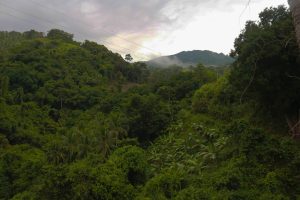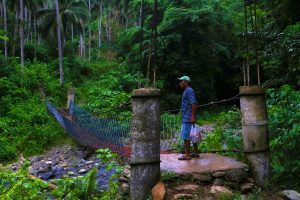Mt. Haguimit, is one of the favorite climb among mountaineering enthusiast and homes one of the ethnic groups in Romblon—the Sibuyan Mangyan Tagabukid.
Located at the lower massif of Mt. Haguimit, in the area covered with Hagimit trees, this tribe isolated from the lowlanders had thrived by consuming root crops and forest produce which the folks also sell to the lowlanders.
Living far from the rest of the townsmen, these people have thrived and continued to flourish in the highlands keeping their culture and their traditions intact. Despite negative experiences with the lowlanders, local tribal chieftain of the Sibuyan Mangyan Tagabukid, Ramon Regala admitted that they still need development and outside influence for them to go along in this modern age.
The struggle to keep their ancestral land theirs

During the times they were threatened by the land grabbing lowlanders, tribal chieftain Regala realized that they should not be deceived by these cunning land grabbers. He recounted an incident where one of his tribesmen were harassed by the land grabbers and the helpless man cannot do anything about it. “Pinapakitaan siya ng kung ano-anong papeles na titulo raw ng lupa, permit ng DENR at kung ano ano pa, hindi sya marunong bumasa at sumulat kaya hindi nya alam ang gagawin nya” [“He was shown documents claiming those are land titles and DENR permits. He doesn’t know how to read and write therefore he was unsure of what to do.”].
These incidents were followed with several attempts by the land grabbers to establish dominance and take the lands of the Sibuyan Mangyan Tagabukid. However, for these people, their land is the only property they own so they sought the help of the local government and other organizations which eventually led to the formation of the Asosasyon ng Tribong Sibuyan Mangyan Tagabukid (ATSMT or commonly known to them as ATSMaTa).
Kabitan river, small yet dangerous
The Sibuyan Mangyan Tagabukid in Lumbang Weste admit that they need to constantly interact with the lowlanders to sell their products. One of the common source of income among the tribe is selling forest products like root crops, medicinal plants, and wild berries. They also sell rice and corn whenever they have excess harvests.
What separates them from the town is the small but ferocious Kabitan river found at the foot of the mountain.
This small body of water threatens the life and the livelihood of the people in Sitio Hagimit as its rise entails a delay in the economic activity of the people and a grave danger for those who dare cross its rapid flow.
One of the tribal members that experienced the wrath of the river is Mrs. Purita Regala, the previous tribal chieftain of the Sibuyan Mangyan Tagabukid and a member of Barangay Representation Team (BRT). Mrs. Regala recalled an incident where she and her child almost got carried by the raging river during a storm in 2013.
“Sumuong kami sa ilog kahit Malaki ang tubig. Habang tumatawid sa ilog ay natisod ako sa bato at naanod kami ng aking anak tatlong taong gulang palang yung bunso ko noon. Mabuti nalang at nahawakan ko ang aking anak at hindi kami tuluyang namatay sa ilog.” [We crossed the river even the current is strong. AS we cross, I tripped on a rock, I and my three our old child were carried by the strong current. Luckily, I had grabbed my child and we were not taken by the current and died.”].
Despite the danger, the people still cross the river. Mr. Dansuy, one of the members of the tribe said that it is better to carefully cross the river on rainy weathers rather than have nothing to put on his family’s plate. However, Mr. Dansuy still fears not for his life, but for his two sons attending high school in Lumbang Weste. Mr. Dansuy accounted, “kami ay nangangamba pag bumababa sila ng masama ang panahon pagkat alam namin na malaki ang tubig sa ilog at mahihirapan silang tumawid.” [We fear when our children go down the mountain during severe weathers because the current in the river is strong and they will have difficulty crossing it.].
The risk of obtaining education
Being one of the early tribe members that attended formal school, Tribal chieftain Regala admitted that what he knew is not enough to continually defend their homeland. He encourages the parents to have their children attend high school in Lumbang Este.
Every morning, high school students from Sitio Hagimit go down from the mountains to reach Lumbang Este High School. These students walk at two o’clock in the morning to reach the foot of the mountain at five o’clock in the morning and bathe at Kabitan river before they continue to walk to the high school.

On rough weathers, most of the students still venture the dangerous path just to reach their school. They often swam across Kabitan river amidst the danger awaiting them. Although there were no recorded casualties, some parents would rather not risk the lives of their children by not allowing them to go to school during severe rainy weathers.
In 2013, A missionary priest from Austria named Lois Ortner came to Sibyan Island. One of the places he visited was Sitio Hagimit. Father Ortner was one of the first people that extend help to the tribe as he built a steel hanging bridge over a portion of Kabitan river in Sitio Hagimit. The bridge has served a great help to the children but according to Mr. Valentin Regla, the Indigenous People Mandatory Representative (IPMR) of Cajidiocan, the terrain of Kabitan river at the foot of the mountain is tricky and more dangerous than the one in Sitio Hagimit.
A safer crossing
When Kapit-Bisig Laban sa Kahirapan Comprehensive and Integrated Delivery of Social (Kalahi CIDSS) came to Cajidiocan, people are hopeful that their community will be funded by the program. The Sibuyan Mangyan Tagabukid first heard about the program when the Community Empowerment Facilitator Genesis Fabiculana went to their sitio to conduct a Barangay Assembly in Lumbang Weste. Together with the tribe, she discussed the objectives of Kalahi CIDSS. As the session finished, the t already came up with a proposed project—a hanging bridge at the foot of the mountain over Kabitan river.
During the participatory situational analysis (PSA) the IPs raised their need to cross safely to Kabitan river. According to Miss Fabiculana, the people raised their concerns about children, pregnant women, and elderly crossing the river. Upon hearing the anecdotes of the tribe people, the community agreed to propose the hanging bridge as their priority project to be funded by Kalahi-CDISS.
During the Municipal Inter-Barangay Forum, Mrs. Regala recalled “pagod at puyat kami noon sa pag eensayo ng presentation namin sa MIBF. Nag pakita kami ng dula kung paano nahihirapan tumawid ng ilog yung aming mga kasamahan tuwing masama ang panahon. Ayun, natuwa naman siguro yung ibang barangay at Nakita yung malaking pangangailangan namin kaya ibinoto kami na ma-prioritize. Masaya na kami ngayon at malapit nang simulan ang aming proyekto.” [we are tired and we lack sleep because we practiced our presentation for the MIBF. We showed a role-play on the difficulty of our people crossing the river during severe weathers. I guess the other barangays were entertained and have seen our great need thus they voted for our project to be prioritized. Now, we are happy that our project is almost to begin.”].
The hanging bridge project for Sitio Hagimit is set to start by July 2017.
The Kapit-Bisig Laban sa Kahirapan Comprehensive and Integrated Delivery of Social Services (Kalahi-CIDSS) is one of the core poverty alleviating programs of the Department of Social Welfare and Development that aims to reduce poverty, improve access to basic social services, and promote good governance by involving the people, mostly the vulnerable sectors to the local planning and decision making in the community.
###
![]()


